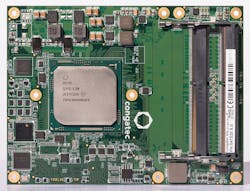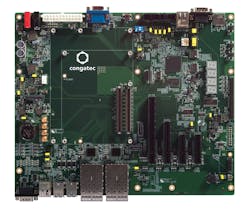Download this article in PDF format.
COM Express Type 7, the new pin-out specification from the PCI Industrial Computer Manufacturers Group (PICMG), is the first module specification dedicated to server technologies. It’s also the first to provide 10-GbE support on the module. This article aims to debunk the myths circulating around COM Express Type 7 and specifies its position in the market.
1. COM Express Type 7 will never become available as an official PICMG standard.
This is false. Admittedly, it took several months for the official release statement of the COM Express 3.0 specification with the new pin-out Type 7. However, since summer 2016, we have seen a PICMG preview launch of the specification and the new specification is now officially available. The predecessor revision 2.1 was launched in 2012, which underscores one of the key benefits offered by module specifications: Long-term availability of identical interfaces and functions even with changing processor generations. With this long-term perspective, it’s not that important whether it takes a few months longer to officially release a specification. It’s more important that it’s done well to ensure availability for many years to come.
2. COM Express Type 7 substitutes COM Express Type 6.
No. COM Express Type 7 is a server-on-module specification. That separates this pin-out specification from all other computer-on-modules: It’s optimized for the demands of embedded edge servers and not for standard embedded computers. Therefore, the new PICMG specification provides, for the first time, an open standard module that can be used effectively in any server design ranging from IoT edge or fog servers and local industrial clouds to carrier-grade installations, including server farms for content distribution.
The first COM Express Type 7 server-on-modules developed by congatec come with two 10-GbE channels equipped with headless computing power from the 16-core Intel Xeon D1577 processor to the Intel Pentium D1519 processor for industrial temperature ranges (‒40°C to +85°C).
Compared to Type 6, several interfaces have been removed to make room for up to four new 10-GbE interfaces and up to eight more PCIe lanes. Removed were all audio and video interfaces as well as four of the eight USB 2.0 ports, the ExpressCard interface, and two of four SATA ports. This freed up 60 pins on the AB connector and 42 pins on the CD connector for the new interfaces.
3. The graphics performance of high-end processors can be made available with COM Express Type 7 modules.
No. The COM Express Type 7 specification is definitely designed for the new server processors; it makes no sense to mix up the application areas. If you want to use local high-end graphics, then choose COM Express Type 6 server-on-modules incorporating the latest Intel Core and Xeon processors with integrated GPUs. But vendors are free to implement graphic cores on the carrier board, if required for general-purpose GPU (GPGPU) data processing, for example.
4. No embedded applications can utilize the new improvements right now.
False. The specification has been released because of the bandwidth bottleneck in connected devices that need to interact in industrial IoT applications, where many devices exchange massive data streams and need to be synchronized in real time.
Other application areas, such as vision-based control systems, include real-time video surveillance of larger areas with various smart cameras that need to follow the movement of people and devices. Medical vision systems need high-performance server technology as well to synchronize with dedicated frame grabbers or digital-signal-processing (DSP) boards. Even deep-learning algorithms for imaging and robotics are something where the synchronization of various virtualized machines needs to be managed.
5. The onboard 10-GbE interface can only be used for system internal communication.
Yes, the distance for the on-module 10-GbE interface supports only signal lanes of up to 1 meter. Designers can use it solely for module-to-carrier board communication and need to transform there to copper or fiber channels. But this provides best flexibility and is quite common on the PCB level.
On the module, the 10-GbE interfaces are defined as 10GBASE-KR single backplane lanes (see IEEE 802.3/49) to keep them from being bound to predefined physical interfaces. Subsequently, the PHY, which defines the physical transmission layer, is not on the module, but instead has to be implemented on the carrier board. This means that the data transmission method—be that copper or fiber-optic cable—only needs to be defined during implementation on the carrier board.
For even greater flexibility, the interfaces can be implemented as interchangeable SFP+ modules. It’s also possible to combine the performance of several 10-GbE signals. Four 10GBASE-KR lanes can be combined in a PHY for 40GBASE-KR4.
Heatpipe-based cooling solutions, such as this heat sink from congatec, are designed for COM Express Type 7 server-on-modules.
6. The 10-GbE interfaces aren’t real-time capable.
Wrong. The COM Express 10GBASE-KR interface feature set provides a software-definable Network Communication Service Interface (NCSI) pin for each of the four interfaces. This physical pin can be configured as an input or output and is controlled by the corresponding Ethernet controller. A typical application is to implement a hardware-based timing protocol in accordance with IEEE 1588 for powerful, connected real-time applications. These can range from smart automation and machine control to aerospace and defense applications.
7. The new 10-GbE modules aren’t suitable for carrier-grade designs.
Wrong. They’re designed for various requirements in both carrier-grade as well as embedded/industrial servers. The first large market is embedded and industrial servers that reside at the customer’s site and require a certain amount of ruggedness and application-specific interfaces for the system design.
The second large market is modular servers in the carrier-grade and server-farm sector. Here, we have software-defined networks (SDN) and network functions virtualization (NFV). In addition, servers reside at the edge of the carrier-grade grids to improve the quality of services for decoding and encoding of high-definition video and audio content. In those applications, an upgrade of the performance is cost-efficiently achievable by exchanging the modules as new processors become available.
Carrier-level applications include virtualized infrastructure computers; dedicated platforms for cloud, edge, and fog servers operated by the carrier; cellular-phone towers; and storage and content distribution systems that require efficient solutions for more performance and ease of scalability. Enterprise-level application fields are primarily found in research centers for content distribution, where service providers for IPTV, cable, and mobile clouds operate server farms close to the edge of the carrier network to deliver device-specific transcoding and on-demand content, as well as in security applications such as Video Surveillance as a Service (VSaaS).
8. The design is only applicable for Intel processor technologies.
No, although today only Intel Xeon processor technologies (codename: Broadwell DE) are a perfect fit for this form factor, with headless computing power from the 16-core Intel Xeon D1577 processor to the Intel Pentium D1519 processor for industrial temperature ranges (‒40°C to +85°C). They offer up to 48 GB of 2400-MHz DDR4 RAM with or without error code correction (ECC), as required by the customer. Nevertheless, in the near future, engineers will be able to also use silicon from other vendors.
Have a look at the latest AMD launches. One can expect that upcoming embedded variants of the Zen microarchitecture will be a good fit as well. There’s nothing integrated in the specification that’s dedicated to just Intel technology. Engineers will get a very attractive modular solution that’s instantly scalable as new server processors become available. This will reduce the design effort to a minimum and, as a result, is the most cost-efficient upgrade path for existing infrastructures. One only needs to change the module and not the entire system.
9. Servers will never get virtualized in industrial environments.
Several years ago, we had the same impression. Then, there were few vendors who wanted to combine the PLC with the GUI and use virtualization software to separate the systems. But we now see two trends: The SDN/NFV trend in carrier-grade business; and the demand to separate real-time systems in industrial applications from the IoT connectivity. These two trends lead to an increasing demand in virtualized server technologies. That’s why it becomes very convenient when vendors of COM Express Type 7 modules support virtualization technologies as well. For example, in industrial and medical real-time applications, the RTS hypervisor is well-accepted.
To get a quick start with COM Express Type 7 modules, congatec offers an evaluation carrier board that routes all defined signals to standard interface connectors. For Ethernet, it offers 10 Gigabit Ethernet SFP+ cages.
10. Cooling solutions are too complex for flat system designs.
Maybe yes, if you want to build them on your own. It’s a definite “no” if you utilize commercial off-the-shelf cooling solutions for COM Express. The COM Express specification defines a standard heat spreader. Its flat surface allows it to be easily integrated into server designs and enables fast technology upgrades without the need for mechanical and/or electrical system architecture changes. This also makes it much easier to follow the constantly changing roadmaps of chip manufacturers. Suitable specification-compliant heat spreaders and heat sinks that are tailored to the module are available, facilitating the developer’s job of integrating the new server-on-modules
11. Carrier boards for servers are difficult to design.
Not with COM Express Type 7 modules. For hardware designers, the module approach makes it most easy to design dedicated boards because the system core is already available in an application-ready format. And evaluation carrier boards for evaluating the server-on-modules are made available from each vendor as well. Some vendors even offer the circuit diagrams and layouts for free, so that they can be used as the basis for customized designs. If, on top of all these offerings, engineers also get personal integration support, then even module-based server designs are greatly simplified.
For those starting out with COM Express Type 7, congatec has a white paper available for download.




